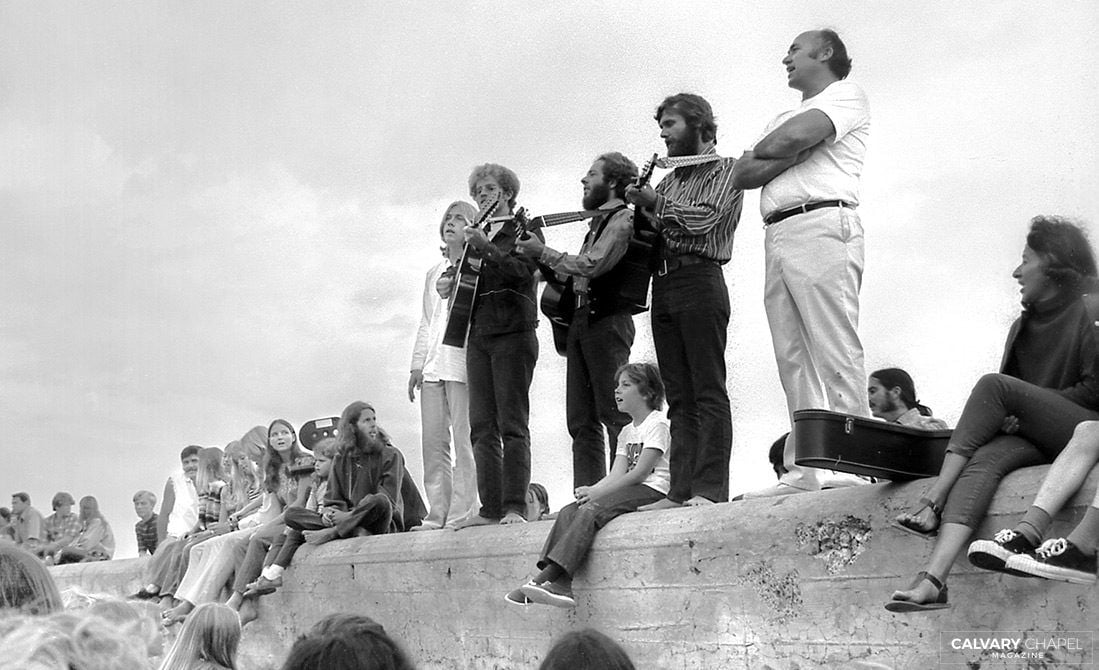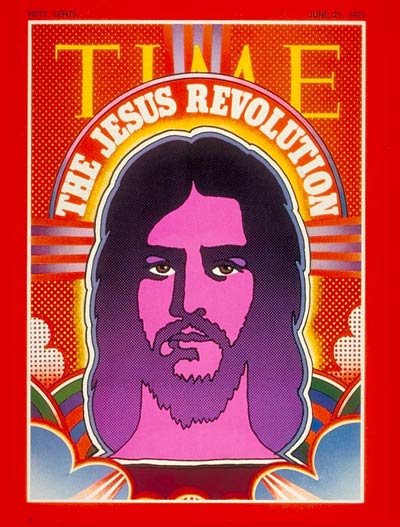The Jesus Revolution: Then & Now
- As with the Jesus Revolution of fifty years ago, God has been preparing the ground for the next Jesus Revolution.

Robb Redman is currently Professor of Theology and Ministry and…
Over fifty years ago, on June 21, 1971, Time Magazine drew the nation’s attention to a rapidly developing phenomenon in American Christianity it called “the Jesus Revolution.”
In contrast to the largely traditional religion embraced by the post-World War II generation, the new religious expression of young baby boomers (born 1946-1964) was characterized by a profound personal and emotional experience of God’s mercy and grace coupled with a genuine desire to live a life of radical discipleship, featuring a passionate personal and corporate worship, Bible study, fellowship, and evangelism.

The desire for an authentic Christian faith was often dismissed as youthful enthusiasm. While the “Jesus people” would often be critical, even judgmental, of their parent’s religion. It seemed cold and conformist, lacking the saltiness and commitment of early Christianity. There was a fair amount of youthful rebellion encouraged by popular culture promoting (some might say creating) a “generation gap” through music, movies, TV, and advertising that contrasted youthful “cool” with the “square” middle-aged, faith based films of middle-class America.
Preparing the Way
The Jesus revolution did not appear out of thin air, there was plenty going on in the post-WWII era that prepared its way. Youth ministries became popular in the late 1940s, led by innovative youth pastors at larger churches and parachurch high school and college ministries, including Campus Crusade for Christ, Youth for Christ, Young Life, InterVarsity Christian Fellowship, and Navigators.
These ministries looked to new media, especially movies, and to popular music to connect with teens and real life young adults. Don Hustad, a musician who worked with Billy Graham in those years, wrote that “Youth for Christ activity was the first twentieth-century emphasis on special worship/evangelism styles for a specific age group.” Youth musicals began to appear in the mid-1960s, designed for youth choirs and accompanied by piano, guitars, and (gasp!) drums.
Youth musicals like Good News (1967) and Tell It Like It Is (1969) were widely adopted and had a significant impact on young Christians in the 1960s in at least two ways: they validated the popular musical styles kids heard on the radio, and they encouraged kids to use their instruments and their music for worship and outreach. They were the seeds that would blossom into the Jesus Revolution.
The California drug culture was in full swing in the late 1960s-early 70s, and the beaches from Los Angeles to Orange County were a favorite hangout for hippies from all over. While traditional churches often shunned them, Pastor Chuck Smith of Calvary Chapel in Costa Mesa welcomed the hippies and won them over with his genial personality and hospitality, and a simple message of the life-changing power of God’s love and forgiveness, ”simply teaching the Word, simply.”
Smith had befriended a dynamic new believer named Lonnie Frisbee, who invited his fellow young hippie friends to the church, in particular, to the midweek Bible studies which featured music from newly converted artists, like Love Song. Calvary Chapel hit the national headlines in January 1972 when Pastor Chuck baptized some 700 people, many of them hippies, in the surf at Corona del Mar. Around that time, Calvary Chapel began taking the message on the road, hosting festivals up and down the west coast featuring new “Jesus music.”
The festivals spun off local Bible study groups that soon formed into Calvary Chapel congregations. Within 20 years, Calvary Chapel had grown to a network of over 1000 churches with more than 25,000 members; at that time, 10 of the 25 largest congregations in the US were Calvary Chapels.
Calvary Chapel was not the only location of the Jesus Revolution and the “Jesus Movement”. Starting in the late 1960s, Christian coffeehouses sprang up in college towns across the country like mushrooms after a rainstorm. In the early 1970s Campus Crusade for Christ held stadium-sized events for tens of thousands of young people.
Mainline Protestant churches – and even Roman Catholic parishes – were experiencing the charismatic renewal. Young people were coming to Christ, and the Church in America would never be the same.
Changed Lives – Transformed Churches
The Jesus Revolution changed the lives of thousands, if not millions, of young people in America and around the world, and it transformed churches as well.
The music of the Jesus revolution connected with the counterculture of the times.
The worship awakening that began in the early 1970s has been well documented. Chuck Fromm used to say that the most significant innovations in worship in the 20th century were the guitar and the overhead projector – a stark contrast to the formal worship of traditional churches, which relied on the organ and the hymnal.
The music of the Jesus Revolution connected with the counterculture of the times, but it pointed to a new kind of worship music, simpler and more direct. Early Jesus music was often Bible verses or short passages of scripture with a rock, folk, pop, or country arrangement. Songs like Come, Let Us Worship and Bow Down, Seek Ye First, Psalm 8, and others were just the beginning of a songwriting wave that continues to the present.

There was more. Besides worship, the Jesus Revolution brought a renewed emphasis on small groups for study and prayer, new ways of doing outreach and evangelism, fresh commitment to social ministry, new styles of ministry leadership, and a wave of church planting.
Young men (and women, for the first time in significant numbers) answered the call to pastoral ministry. Seminary enrollments surged in the 1970s-80s across the country and before long, churches found themselves led by the former hippies they had previously shunned.
What lessons does the Jesus Revolution hold for us today?
Consider the similarities between then and now. One that leaps out is a generation of youth estranged from God yet searching desperately for meaning and purpose in their lives. Pew Research reports that among Millennials, those reporting no religious affiliation are approaching 30%, well above the national average for Nones.
A generation of youth estranged from God yet searching desperately for meaning and purpose in their lives…
Now, as then, powerful cultural forces are trying to push young people away from God. Replace sex, drugs, and rock & roll with digital technology, entertainment culture, and social media, and you have the same sort of cultural factors that promise everything but deliver nothing, leaving young people feeling empty, lonely, and in despair.
The growing number of teen and young adult suicides and other “deaths of despair,” especially during the Covid-19 pandemic, should be a wake-up call for pastors and other ministry leaders in much the same way the widespread drug abuse that damaged young people led Pastor Chuck Smith and others to open the doors of their churches and ministries to them.
Greg Laurie, who was saved during the heyday of the Jesus Revolution, observes,
“Looking back on the late 1960s and early 1970s, I see a lot of parallels between then and now. It was a divided nation back then. Things were very dark. But when things are very dark, God’s light can shine brightly. I think we’re due for another Jesus Revolution.”
While many are tempted to write off Millennials in much the same way the young Baby Boomers were often dismissed by their elders, young people today hunger for more, they are weary of the culture’s endless vacuous loop of “just be yourself.”
Teens and young adults may not affiliate with a specific religious group, yet they are more open to conversations about God and Jesus than many realize. The search will only become more desperate.
Build stronger connections between congregations and their neighborhoods through service and witness.
As with the Jesus Revolution of fifty years ago, God has been preparing the ground for the next Jesus Revolution. Some hopeful signs include a renewed interest in deeper biblical and theological foundations for ministry and a rejection of simple pragmatism, renewed interest in the ancient practices of worship and discipleship, and a desire to build stronger connections between congregations and their neighborhoods through service and witness.
When will it happen? What will it look like? That’s not really for us to know, but The Asbury Revival is a very encouraging sign of what may be on the horizon. But we can expect the results to be no less life-changing than the original Jesus Revolution and no less transforming of our churches.
Our Latest Devotional Podcast
What's Your Reaction?
Robb Redman is currently Professor of Theology and Ministry and Director of Ministry Programs at South College (TN). He also serves as Consulting Editor for Worship Leader magazine since its inception in 1992. He has previously served as an academic leader at Fuller Theological Seminary, A.W. Tozer Theological Seminary/Simpson University, Multnomah Biblical Seminary/Multnomah University, and South University. Ordained in the Christian & Missionary Alliance, he has pastored congregations in Oregon, California, Texas, and Georgia. He currently lives near Savannah, GA.





